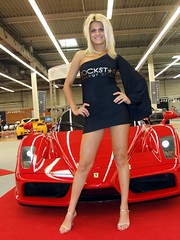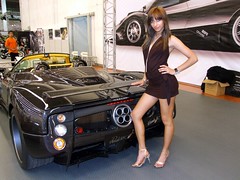The Nissan GT-R has been the darling of the frothing-at-the-mouth sports car crowd since it debuted in 2008. At the time, it offered the performance of an Enzo at a (small) fraction of the price. But no car is an island, and competition moves on – so the GT-R has been upgraded for 2012 to keep pace with it’s ferocious opponents.
From the outside, the car gets some almost-noticeable aerodynamic tweaks. The GT-R gets a new front and rear bumper, integrated LED running lights, and a claimed 10% increase in downforce with a minor decrease in aerodynamic drag. Changes on the front bumper also increase the amount of air passing through to cool the engine and brakes, and the rear bumper evacuates more air from the wheel wells for more downforce and brake cooling as well. The GT-R still isn’t pretty, but it’s “angry sumo wrestler” looks remain in full force.
On the performance side of things, prepare to be upset if you just bought a 2011 GT-R. Peak horsepower increases from 480 to 530, and torque jumps from 435lb-ft to 451lb-ft. If you opt for the Spec V model, torque peak bumps to 466lb-ft in the higher gears. The increase in output comes from higher boost pressure (obviously) as well as a reprogrammed ECU, larger exhaust piping and a less restrictive intake, and tweaks to the valve timing and air fuel ratios. There’s also a new catalytic converter, and surprisingly the GT-R qualifies as an SU-LEV (super ultra low emissions vehicle) – which is cool for a car than can run to 60 in close to 3 seconds flat.
The body itself has been stiffened, with a strut-tower brace in the engine compartment (which Nissan says is made of carbon fibre and aluminum honeycomb) as well as a support on the passenger side of the instrument panel. The changes to the suspension border on the obsessively nerdy, too. Front spring/damping rates and roll bar have been tweaked and the caster angle has been increased, while the rear suspension is re-engineered for a lower roll center height to improve toe. The shocks are a new low-resistance design that’s supposed to be more responsive. Finally, the 2012 gets a new brake rotor design for better braking force, less fade, and better wear characteristics. In addition, a new set of forged wheels (from Rays engineering) reduce unsprung mass and are stronger to boot.
There are minor changes to make the interior, long the GT-R’s weak spot, a nicer plate to spend time. Although things like a new seat design and a new finish for the GT-R logo don’t make the car lap the ‘ring any faster (which, by the way, is now down to 7:20 according to Nissan, irrelevant as that may be), it’ll be nice to not feel like you’re in an optioned-up Altima now.
The 2012 GT-R will be offered in a large array of models, from the stripped out Club Track model, through the Pure, Premium, and Black editions, the performance-tuned VSpec, and the exclusive customized EGOIST model. Pure, Premium, and Black editions are just trim levels with no real mechanical differences, but the VSpec and Egoist get a few changes. VSpec models continue to have the lightweight Rays racing forged alloy wheels as last year, painted black. There’s also the increased peak torque output as mentioned earlier, as well as a titanium exhaust system. The VSpec gets track-worthy brake pad composition, as well as re-calibrated VDC stability control for track use, and a dry-carbon rear spoiler.
The EGOIST takes all of the upgrades to the VSpec and adds some custom touches on top of them. Foremost is the custom leather interior with handmade quilt-stitched seats by craftsmen Muelheim an der Ruhr in Germany, available in 20 different upper and lower color combinations. The GT-R logo on the steering wheel is hand-lacquered by a master artisan in Japan, and the Bose stereo is – get this – custom calibrated for ideal sound depending on each specific customer’s driving position. Oh, and it has carbon-composite speaker cones.
The 2012 GT-R will be hitting markets worldwide in February of 2011, so if you were thinking about purchasing the Swiss Army Knife of sports cars, it might be worth it to wait a few more months.





















